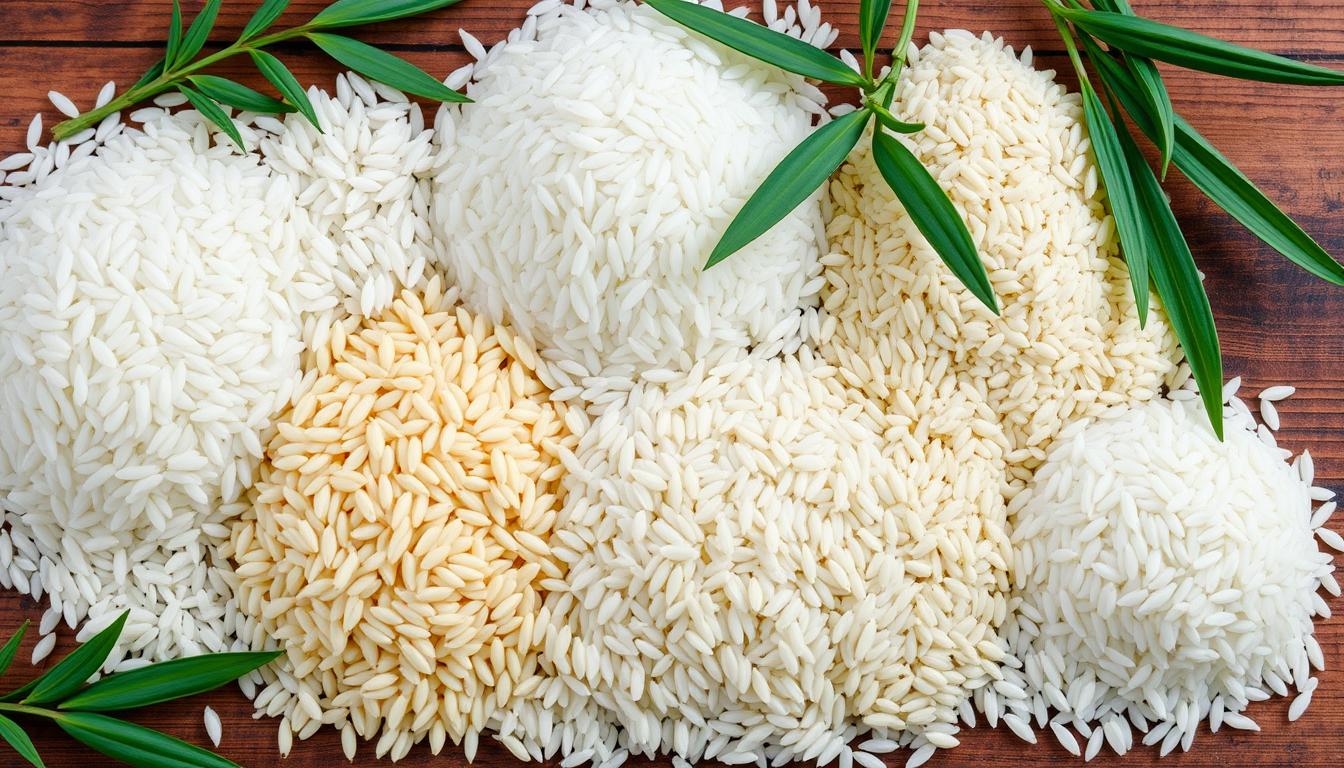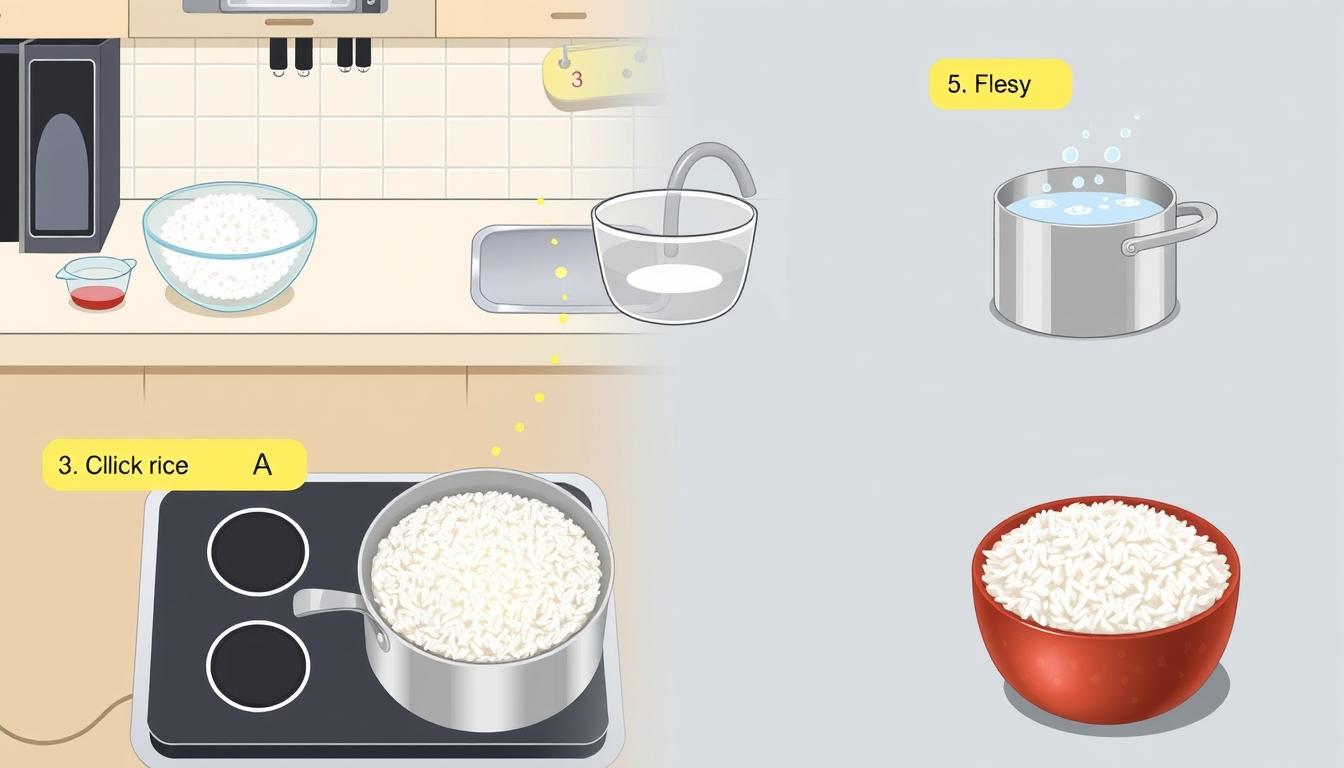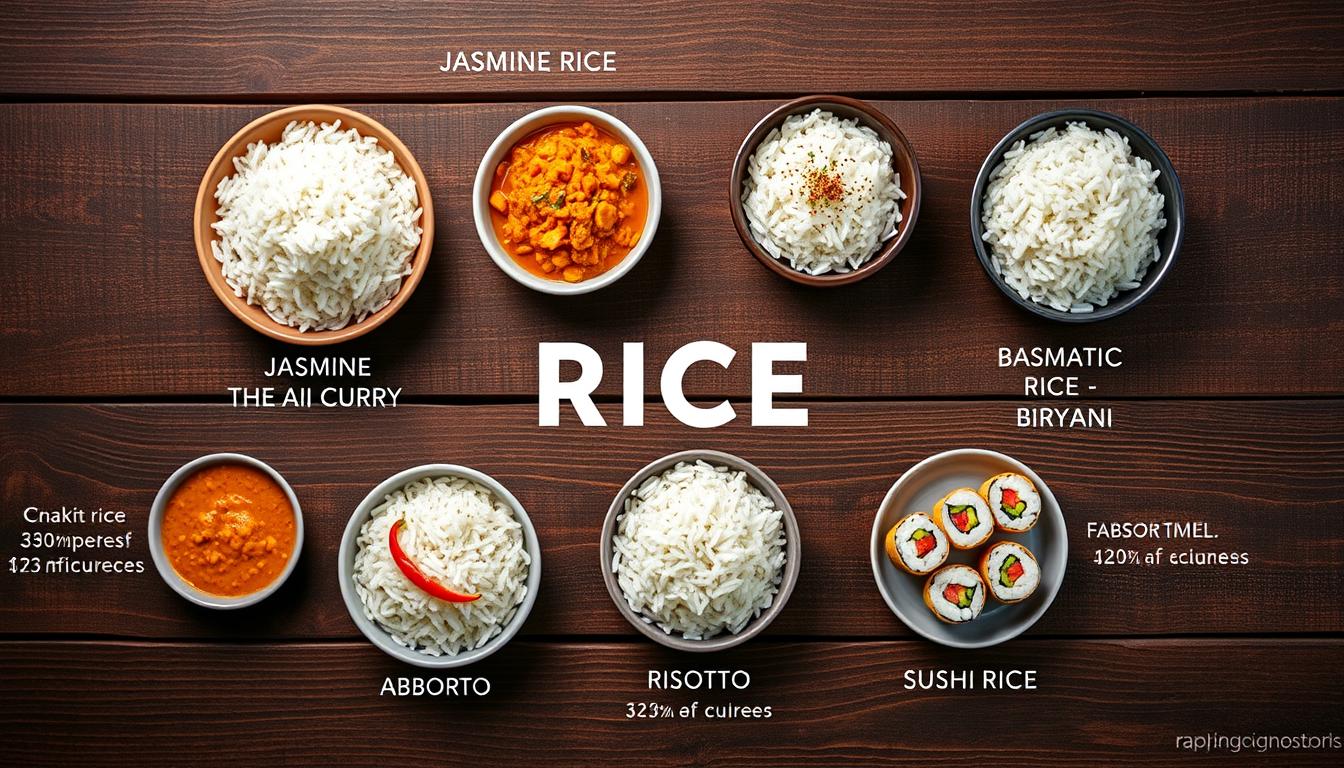Adding rice to your baby’s diet is a smart move. It’s packed with nutrients and easy to digest. The best time to start with rice cereal is between 4 to 6 months. This is a key period for your baby’s growth.
This article will guide you on choosing the right rice for your baby. You’ll also learn how to cook it safely and effectively. This ensures your baby gets the most nutritional benefits from rice.
Discover the best rice options, like organic brown rice and white Basmati rice. Learn the best ways to cook it. Proper cooking is key to keeping rice nutritious and safe for your baby.
By following these tips, you can add rice to your baby’s meals. This will help them grow strong and healthy on this nutritious food.
Introduction to Rice as a Baby Food
Rice is a favorite food for many around the world. It’s soft and easy to digest, making it perfect for babies. Parents often start giving rice to their babies at six months, following the World Health Organization’s advice.
Rice is a great source of carbs for energy. It also has important vitamins and minerals for a baby’s growth. A serving of rice porridge has about 201 calories, with 28g of carbs and 11g of protein. It also has 5g of fat, 23mg of cholesterol, 45mg of sodium, 278mg of potassium, and 1g of fiber.
Brown rice is more nutritious than white rice but has more arsenic. Cooking methods like parboiling can lower arsenic levels. It’s important to prepare rice porridge safely and nutritionally.
| Nutritional Content (per serving) | Rice Porridge |
|---|---|
| Calories | 201 kcal |
| Carbohydrates | 28g |
| Protein | 11g |
| Total Fat | 5g |
| Cholesterol | 23mg |
| Sodium | 45mg |
| Potassium | 278mg |
| Fiber | 1g |
| Calcium | 35mg |
| Iron | 2mg |
Why Choose Rice for Babies?
Adding rice to your baby’s diet can be very beneficial. It’s a key food in many cultures. It helps your baby get important nutrients and try new tastes.
High Nutritional Value
Rice is packed with carbs, giving your baby lots of energy. It also has B vitamins, iron, and minerals like magnesium and selenium. Fortified baby rice and porridge offer even more nutrients.
Studies show that introducing nutrient-rich flavors early can make your child more adventurous with food.
Gentle on the Digestive System
Rice is soft and easy to digest, which is great for babies. It’s gluten-free, so it’s less likely to cause allergies or upset stomachs. Starting with rice can make the transition to solid foods smoother.
Blending rice with fruits or veggies can make meals more exciting. It also adds more nutrients, helping your baby have a varied diet from the start.
Types of Rice Suitable for Infants
Choosing the right rice for your baby is important. Each type of rice has its own nutritional benefits. Knowing the options can help you make the best choice for your baby.
Organic Brown Rice
Organic brown rice is a good choice because it keeps its bran and germ. This makes it more nutritious than white rice. It has fiber, vitamins, and minerals that help your baby grow.
But, brown rice can have more arsenic. So, it’s important to cook it properly.
White Basmati Rice
White basmati rice is a top pick for babies. It has a mild taste and a nice smell. It also has less arsenic and is gentle on your baby’s stomach.
It cooks fast and is great in both savory and sweet dishes.
Red Rice
Red rice is another good choice. It’s packed with antioxidants. It has anthocyanins, which are good for iron, making it safe for babies around 7-8 months old.
| Type of Rice | Nutritional Benefits | Arsenic Levels | Recommended Age for Introduction |
|---|---|---|---|
| Organic Brown Rice | High in fiber, vitamins, and minerals | Higher | 6+ months |
| White Basmati Rice | Easy to digest; low in arsenic | Lower | 6+ months |
| Red Rice | Rich in iron and antioxidants | Varied | 7-8+ months |
Rice for Babies: Best Types and Cooking Methods
Choosing the right rice for your baby is key. It must be nutritious and safe. Rice is a popular choice, but it’s important to know how to prepare it safely.
Choosing the Right Rice Variety
Look for rice with low arsenic levels. White basmati rice from California is a good choice. Organic rice is also safe, but it may have some arsenic too.
Brown rice has more arsenic than white rice. It’s best to limit brown rice in your baby’s diet.
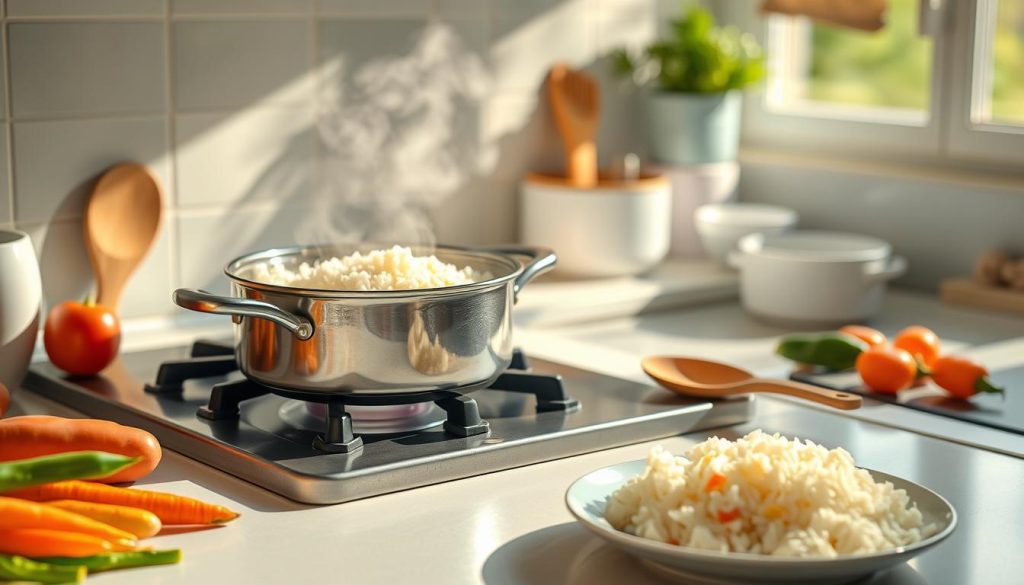
Health Considerations (Arsenic Levels)
It’s important to know about arsenic in rice for babies. Infant rice cereal can have a lot of arsenic. This is bad for their health.
Infants and young children are at high risk. To keep them safe, mix different grains in their diet. Offer rice in small amounts.
Good cooking methods can lower arsenic levels. Rinsing rice and using a lot of water can help. Boiling rice can remove even more arsenic.
These steps make rice safer and more nutritious for your baby.
| Rice Type | Inorganic Arsenic Level | Cooking Method Effectiveness |
|---|---|---|
| California White Basmati | Lowest | 74% reduction by boiling |
| Organic Brown Rice | Higher (80% more than white) | 50% reduction by boiling |
| Other Brown Rice Varieties | Higher | 30% reduction by rinsing |
| Commercial Infant Rice Cereal | Up to 5 times higher than oats | N/A |
Cooking Rice for Babies: Best Cooking Methods
Choosing the right way to cook rice for babies is key. It must be safe and easy to digest. Certain washing and cooking steps can greatly improve the rice’s nutritional value and taste.
Rinsing and Soaking Techniques
Washing rice well before cooking is a must to cut down on arsenic. Rinse your rice 4-5 times until the water is clear. This step removes harmful substances and gets the rice ready for cooking.
After rinsing, soaking the rice for about 30 minutes can make it softer. This makes it easier for your baby to digest.
Traditional Cooking Methods
Using traditional cooking methods is important for making rice safe for babies. Use 6 cups of water for every 1 cup of rice. After cooking, drain off any extra water to reduce arsenic levels by about 30%.
Cooking rice takes around 15 to 25 minutes. Add 5 more minutes for steaming to get it soft enough for infants.
Preparing Rice Porridge
Rice porridge is a great first food for babies over 6 months. It’s smooth and gentle on their stomachs. Making rice porridge takes about 10 minutes, with a total cooking time of 25 minutes.
Start with 1-2 tablespoons of porridge a day. You can increase it as your baby gets hungrier. Adding flavor enhancers like ajwain or moong dal makes meals nutritious and tasty.
Introducing Rice to Your Baby’s Diet
Introducing rice to your baby’s diet is a big step. You can start around six months, when they show they’re ready. It’s important to watch for signs to make the transition smooth.
Signs of Readiness for Solid Foods
Before you start with rice, look for these signs:
- Ability to sit upright with minimal support
- Good head and neck control
- Active interest in food during family mealtimes
- Loss of the tongue-thrust reflex
- Ability to move food from front to back of the mouth
- Maintenance of a healthy weight and development curve
- Opening mouth when offered food on a spoon
Starting with Small Portions
Start with small portions of rice for your baby’s first try. This helps them get used to new tastes and textures. It also lets you watch for any signs of allergy or intolerance. Here’s a simple guide to follow:
| Stage | Recommended Age | Serving Size | Cooking Time |
|---|---|---|---|
| Stage 1 (Basic rice porridge) | 6-7 months | 2 tablespoons organic rice | 20-25 minutes |
| Stage 2 (Mashed rice) | 7-8 months | 3 tablespoons rice | 25-30 minutes |
| Stage 3 (Soft rice) | 9+ months | ¼ cup rice | Cook until soft but maintains shape |
Mixing Rice with Other Foods
Once your baby likes plain rice, mix it with other foods. Try adding pureed fruits like bananas or applesauce. You can also mix in vegetables like carrots or peas. Adding proteins like lentils makes it even better for your baby.
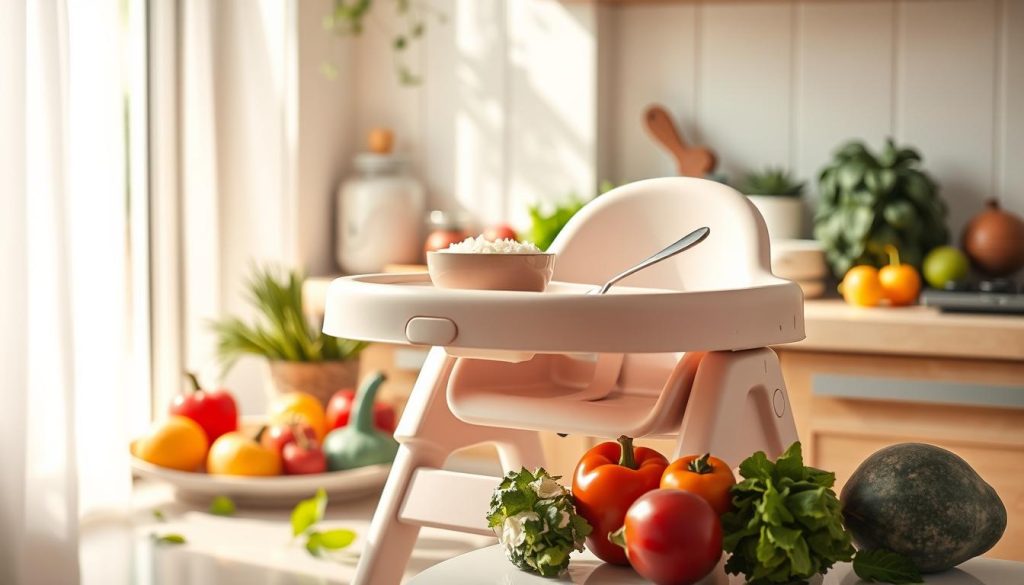
Always start with rice once a day and slowly add more as your baby gets used to it. This careful way of introducing rice can help your baby love healthy foods for life.
Food Safety Tips for Preparing Rice
Keeping rice safe is key, more so for families with young kids. Safe handling and storage can lower risks. Following these tips will make meals safe and enjoyable for your family.
Proper Storage of Cooked Rice
To keep leftover rice safe, store it in airtight containers within two hours of cooking. Use it within 24 hours to avoid harmful bacteria. Cool rice quickly by spreading it out or using small portions in the fridge.
This method keeps rice out of the danger zone (41°F to 135°F). It helps prevent bacterial growth.
Reheating Leftover Rice Safely
Reheat leftover rice to at least 165°F (74°C) to kill bacteria. It’s important to reheat rice only once. This reduces the risk of foodborne illnesses.
By following these rice safety tips, you can avoid foodborne illnesses. It’s vital for families, but even more so for infants. Proper storage and reheating are key to your family’s health.
| Food Safety Practice | Description | Why It Matters |
|---|---|---|
| Storage Time | Use cooked rice within 24 hours. | Limits bacterial growth. |
| Cooling Method | Cool rice quickly after cooking. | Prevents staying in danger zone. |
| Reheating Temperature | Reheat to at least 165°F (74°C). | Kills harmful bacteria. |
| Reheating Limit | Do not reheat rice more than once. | Reduces risk of foodborne illness. |
Conclusion
Rice can be good for your baby’s diet if introduced correctly. Health groups like the American Academy of Pediatrics say wait until about 6 months to start solids. It’s key for their digestive system to grow.
When picking rice, choose safe rice options for infants to avoid harmful stuff like arsenic. Cooking and storing rice right makes it better for your baby. It also makes meals fun and safe.
Start with a mix of grains and rice to keep meals balanced. This helps your baby like food from the start. Watching how your baby reacts helps make meals better for them.
Thinking about these points helps you introduce rice well to your baby. This summary of rice for babies shows how important careful preparation and slow introduction are. It helps your baby develop good eating habits for life.
Source Links
- How to Make Baby Rice Cereal (Freezer-Friendly!) | Baby Foode
- Vegetable Rice
- Rice Porridge for Babies
- Starting Solids – Why I Don’t Recommend Baby Rice
- Should My Baby’s First Food Be Baby Rice Or Porridge? – SR Nutrition
- Rice Cereal for babies – Is it necessary?
- Vegetable Pilaf Rice | Baby Led Weaning & Toddler Recipe
- Can Babies Eat Rice and Rice Cereal? – Solid Starts
- How to: Brown Rice for All Ages
- Homemade Baby Rice Cereal – Yummy Toddler Food
- Rice for babies: the ultimate guide on how to serve it safely – My Little Eater
- All About Rice For Babies – Food Safety When Weaning – SR Nutrition
- Manoomin (Wild Rice) for Babies – First Foods for Babies
- How to Cook Rice
- Rice Porridge Recipe for Babies
- The Best Rice for Babies and How to Serve it Safely
- 4 Rice Recipes for Babies | 1st Solid Food for 6 Months
- Making Your Own Baby Food | Happy Baby Organics
- Health Risks of Undercooked Knorr Rice Sides: Safe Preparation Tips
- Food Safety | Northeast Colorado Health Department
- Starting Solids With Baby: Purees vs Baby-Led Weaning
- Your baby’s first solid foods
